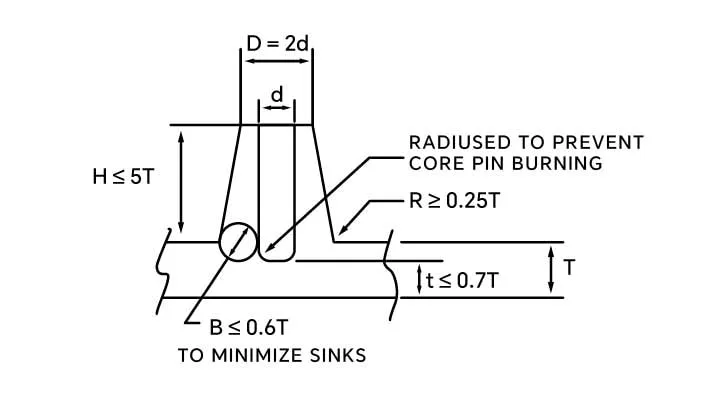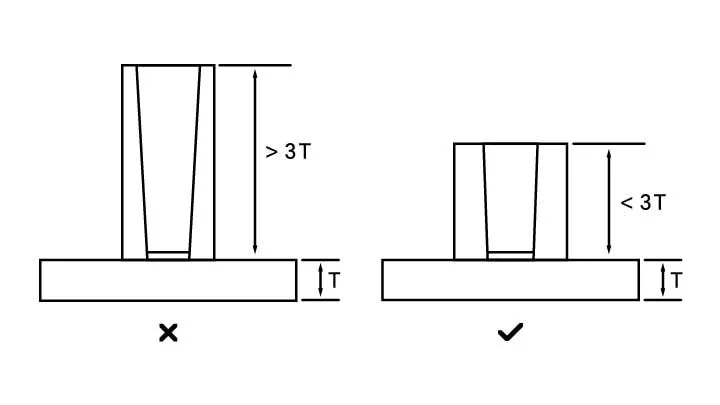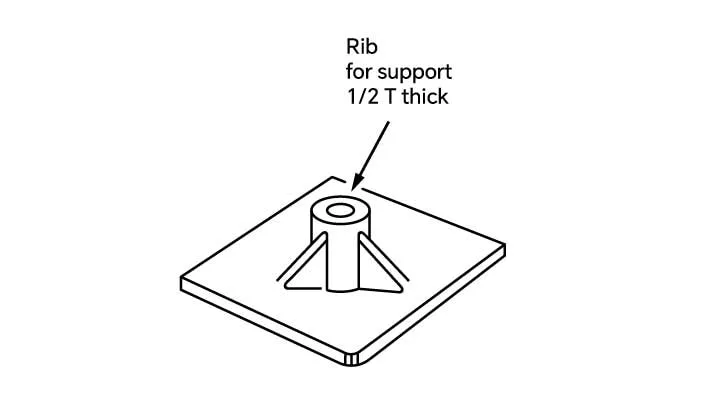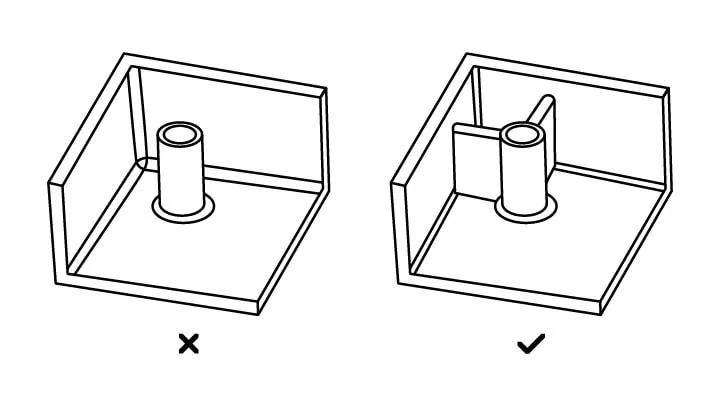Molded parts designing is complex and involves a multitude of factors such as functional requirements, material selection, and structural considerations. Various elements, including wall thickness, draft, ribs, holes, and bosses, must be carefully considered to create effective molded part designs. This blog explores fundamental guidelines for molded parts boss design. Following these guidelines can improve moldability, enhance mold life, increase part durability, and reduce manufacturing costs.
What is Boss Design for Molded Parts?
For plastic molded part design, understanding the concept of boss design is important. So, what exactly is a boss in the context of molded parts? In essence, a boss is a structural feature, a cylindrical projection with holes within molded parts. They serve various functions, including but not limited to providing attachment points for screws, fasteners, or other assembly hardware. These features enable seamless assembly processes and ensure the structural integrity of the final product.

Purpose of Boss Design
Boss design in molded parts isn’t just a matter of aesthetics; it’s a strategic choice with several crucial purposes.
Enhance Strength:
One primary purpose of bosses is to provide structural reinforcement to a molded component. These raised sections distribute loads, enhance rigidity, and prevent deflection, ensuring the integrity of the part under various stresses.
Accommodating Fasteners:
The other purpose is to make the part thicker where the screw connects to prevent cracking and ensure the screw stays tight. Without this, the screw can’t hold securely.
Boss Design Guidelines for Molded Plastic Parts:
1. Base Radius for Bosses
To reduce stress, it’s essential to include a minimum radius at the base of a boss. The point where the boss meets the nominal wall is typically stressed, and stress will rise without a radius. However, the radius at the base of the boss should not exceed a maximum value to avoid thick sections. The recommended range for this base radius falls between 0.25 to 0.5 times the nominal wall thickness. This range not only imparts strength but also ensures smooth ejection from the mold, streamlining the manufacturing process.
2. Spacing Between Bosses
Placing bosses too close to each other will create thin areas that are challenging to cool and can impact quality and productivity. Thin mold walls are hard to manufacture and can lead to issues like hot spots and uneven cooling, and results in reduced mold life. Therefore, it’s advisable to maintain a spacing between bosses of at least 2 times the nominal wall thickness.

3. Hole Base Radius for Bosses
Adding a radius to the core pin avoids sharp corners, making molding easier and reducing stress concentration. It’s suggested to have the radius at the hole’s base in the boss be 0.25 to 0.5 times the wall thickness.
4. Minimum Draft for Boss Outer Diameter
To ensure an easy demould, a suitable draft on the outer diameter (OD) of a boss is required. This draft is typically greater than or equal to 0.5 degrees.
5. Minimum Draft for Boss Inner Diameter
The designs need a minimum taper on the inner diameter(ID) of a boss for proper engagement with a fastener. The draft is on the boss’s inner walls, with a recommended minimum value of greater than or equal to 0.25 degrees. Not only does it allow for easy demould, but it also guarantees a proper and secure fit for fasteners.
6. Optimal Boss Height to Outer Diameter Ratio
The advised boss height is less than three times the outer diameter (OD). Because too high a boss can result in undesired material mass and thick sections at the base. This is not easy to cool, and also extends the cycle time, and impacts the dimensional accuracy of cored holes.

7. Optimal Tip Radius for Bosses
To ensure their durability and longevity, it’s important to design a fillet with a specific minimum radius value at the tip of a boss. This radius will help to reduce stress.
8. Chamfer at the top of Boss
The boss should have a chamfer on top. A chamfer at the top of the boss is a good lead-in for the fasteners.
9. Wall Thickness of Boss
The ideal Boss wall thickness should be about 60 percent of the nominal wall to prevent sinking issues. Exceeding this thickness can lead to voids, sink marks, and longer cycle times. However, if the boss is in a non-visible area, you can increase the wall thickness to increase higher stresses from self-tapping screws.

10. Standalone Boss
When dealing with bosses and other thick sections, coring is a recommended approach. Attaching the boss to the sidewall ensures even material flow and additional load distribution for the part. For improved rigidity and material flow, it’s best to connect a boss to the nearest side wall.

The Challenges and Solutions in Boss Design
The boss’s design comes with various challenges that impact both aesthetics and functionality. In this section, we will explore some common challenges and their solutions.
Causing Sink Marks and Warpage
- Challenge: Improper boss design can result in sink marks and warpage. When the boss is too thick or lacks proper reinforcement, it cools at a different rate than the surrounding areas. This temperature difference can lead to sink marks, which are depressions on the surface, and warpage, causing the part to deviate from its intended shape.
- Solution: To solve this issue, optimizing wall thickness and adding ribs for reinforcement are effective solutions. Proper wall thickness helps ensure uniform cooling, reducing the risk of sink marks and warpages. Reinforcement ribs can distribute stress more evenly, preventing localized deformation.
Impact Cooling Time and Cycle Time
- Challenge: Bosses have a direct impact on cooling and cycle times during molding. If bosses are too thick or improperly designed, they may trap heat, extending cooling time and cycle time. This can slow down the manufacturing process and increase production costs.
- Solution: Consider adjusting cooling channels within the mold to ensure efficient cooling. Additionally, optimizing the overall mold design, especially the placement of bosses, can help minimize the impact on cooling and cycle times.
Limited Material Selection and Compatibility
- Challenge: The molded part material selection will directly affect the boss’s design. Selecting an incompatible material can lead to issues like excessive stress on the boss, which may result in cracking or failure.
- Solution: Selecting the right material is important for boss design. Opt for a material with the necessary strength, stiffness, and chemical resistance to ensure the boss can endure the loads and environmental conditions it will face.
Conclusion
Bosses in injection molded parts are important features, often serving as anchors, supports, and facilitators of reliable assembly. These components play a significant role in ensuring the structural integrity and performance of the final product. Following to fundamental design guidelines is key to producing plastic parts with strong, functional, and visually appealing bosses. Do you need quality molded parts with a reliable boss design? Zhongde’s injection molding services are your ideal choice. Our experienced team is dedicated to meeting your specific requirements, offering a wide range of materials, surface finishes, and intricate geometries. We’re committed to delivering reliable solutions to meet your unique needs. Trust Zhongde for precise, efficient, and cost-effective plastic part manufacturing.
Optimize Your Molded Part Design Today!



